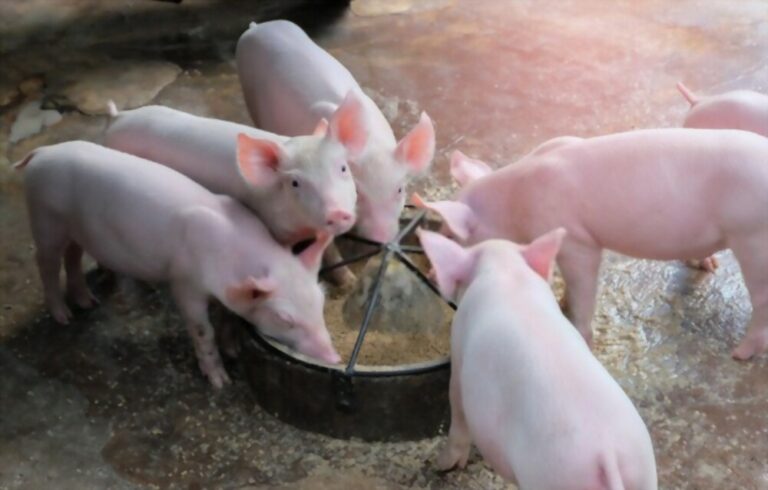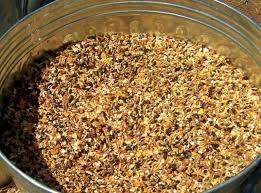Pigs are monogastric animals, implying they only have one stomach. Pigs are omnivores, which means they consume food that is of both animal and plant origin. It can be surprising to learn that pigs have one stomach while cattle have four.
Pigs are well-known for their voracious appetites and rapid growth. Furthermore, there is a vast belief that these animals have a very unusual digestive system. But what is and how does their digestive system function? Let’s explore it further!
Functions of a Pig’s Stomach
A pig’s stomach is the organ in the digestive system responsible for breaking down food. These animals mature and develop a greater appetite. In pigs, the stomach is significant during growth.
Herbivores make up the majority of creatures with many digestive chambers. Pigs only have one stomach, unlike the four stomachs found in other animals. As a result, they cannot eat excessive amounts of grass or hay.
A pig may consume 6 to 8 pounds per day. When weaning is complete, the hunger begins to increase. Their stomachs are essential for storing and digesting the nutrients from the food they eat. Additionally, their gut contributes to their growth at the same time.
Due to their many stomachs, they can now digest hard and coarse food. Like humans, pigs only have one stomach; therefore, they can only eat soft, simple-to-digest things.
How Many Stomach Does a Pig Have?
Like humans and other animals, Pigs only have a straightforward, single-chambered stomach. However, there are three more chambers for some species, like goats, sheep, and cattle.
Birds have two stomachs because they have an extra one. While the other is the muscular stomach or gizzard, the first operates like a pig’s stomach. They need many compartments to digest grass and hay, as these are the things they consume most of the time.
Like all animals, pigs do digest their food. Given how fast they eat, You would question whether these creatures ever digest the food they consume.
These creatures enjoy eating soft, simple-to-eat food. However, they might have strong teeth to withstand tough food, such as raw crops. Furthermore, they favor food that requires minimal chewing.
As a result, many individuals prefer to combine feed with water, encouraging these pigs to consume more food. They still digest their meals even though they choose to chew less. Their stomach makes up for that food that they hardly chewed. It is vital to keep your digestive system healthy because of this.

Most pigs consume a combination of plant-based foods. Fiber will support their digestion by preserving a healthy stomach. Consider providing fiber-rich goodies like hay and wheat blended with their meals.
Due to a parasite called trichinae that lives in the muscle tissue and can spread to people, eating pork from pigs given raw meat can be deadly.
How Large Is a Pig’s Stomach?
Pigs that are adults have stomachs that makeup 0.6% of their whole weight. So, a 400-pound hog has a 2.4-pound stomach.
The age of the animal has an impact on the animal’s storage capacity. For instance, a newborn piglet’s stomach can only hold 30 ml.
Adults can take anywhere from 3.5 to 5 liters depending on their stature. The cause is that when these animals are full, they often play and trample over food. As a result, many pig farmers say feeding twice daily is adequate. If you provide too much food, it can go to waste.
Do Pigs Have 3-Compartment Stomachs?
The idea that pigs have three stomachs is a prevalent one. That’s not accurate, though. With only one stomach, these creatures’ digestive systems are identical to humans.
Llamas, alpacas, and camels are among the creatures classified as camelids. There are even more than three in some creatures. Cattle, sheep, goats, buffalo, and deer are the ruminant animals that we refer to.

Similarities Between a Pig and Human Digestive Systems
The number of stomachs and how they function in a pig’s digestive tract is comparable to those in humans. Pigs and humans only have one stomach, although other animals like cattle, sheep, and goats have four.
- Stomach Type: Monogastric refers to having one stomach. The procedure is the same since the digestive systems of pigs and humans are comparable. Like humans and animals like cats and dogs, pigs have a single stomach.
- Food Chewing: These animals chew their food before ingesting it through the esophagus, storing it in the stomach, and breaking it down there. In the intestine, the last digesting also takes place. Finally, the anus serves to expel the waste.
- Digestive Issues: Both share the same digestive issues because their processes are identical. For instance, lining inflammation in the stomach might lead to serious problems. This condition, popularly known as gastritis, causes severe vomiting.
Differences Between a Pig and Human Digestive Systems
While there are a lot of similarities between a pig’s digestive system and that of a human, the significant difference between them is the size.
Although, we ascertained that a human’s digestive system is somewhat small compared to a pig’s. However, the human large intestine is smaller than a pig’s.
Pigs have a monogastric digestive system, which is like that of humans. The food these animals ingest first gets chewed in the mouth. After chewing, the pig swallows the food and travels via the esophagus to the stomach.
The process of breaking down the nutrients in food begins in the stomach. To metabolize the nutrients, it combines with gastric acids. Complete removal of nutrients and absorption takes place in the small intestine. Furthermore, complete waste is removed through the anus and the big intestines. The pancreas and liver both produce enzymes that aid in small intestine digestion.
These creatures have one stomach. As a result, the digestive system has no means to process foods high in fiber, like hay. Pigs have difficulty digesting it, so if fed, it should only be in limited amounts.
Conclusion
Pigs are monogastric animals like humans. They don’t have three stomachs, despite popular misconception.
Having only one stomach with its primary function centered on breaking down essential foods, it’s important to note that a pig’s growth and general health hinge on its stomach.






